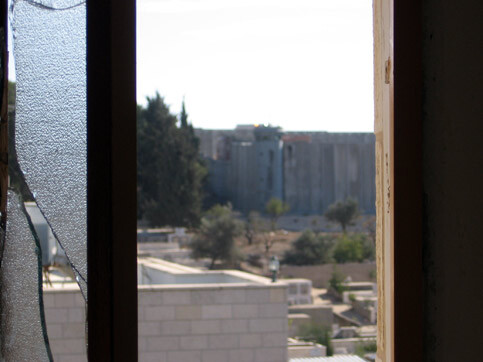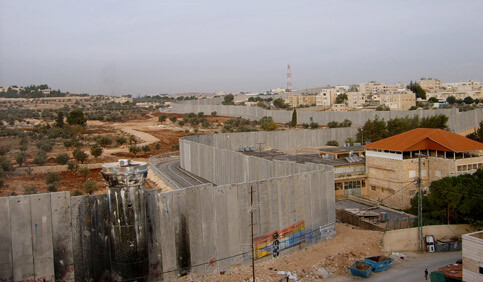Chicago, United States 30 December 2006

A view from the window of the balcony where Miras was shot. (Lajee Youth Center)
On Friday, December 8, six gunshots pierced the afternoon calm and six children started screaming. The cousins had been playing together with their usual gusto on the third-story veranda of their home in Aida Refugee Camp in the West Bank. A bullet tore through the slender body of one of them, a thirteen-year-old boy named Miras Al-Azzah. Several more bullets hit the stone house, and splinters of debris sliced into the bodies of the other children: Athal (10) and Rowaid (8), Miras’s younger sister and brother, and Maysan (12), Zaid (7), and Ansam (3).
Miras stumbled downstairs for help. Though it might seem that shrapnel and blood had materialized from thin air, he knew what had happened. As he was playing the role of soldier in the popular game “Jaysh wa Arab” - “Army and the Arabs” - the Israeli soldiers stationed perhaps 100 meters away had taken aim at him and fired.
Lucky Cousins
Despite the horror of that afternoon, the Al-Azzah children are lucky cousins, and not only because at the end of the day Miras was in stable condition in a Bethlehem hospital and all of the other children were at safe home.
Fifty-eight years ago, Mohammad and Ruwaida Al-Azzah fled their village during a war in which nearby Palestinian villagers suffered massacres at the hands of Zionist militias, and Palestinians were, for many reasons, left without a strong defense. They left Beit Jibreen, a stately village of vast wheat fields and Roman ruins and became refugees perhaps a half-hour drive away on the outskirts of Bethlehem. They could not have imagined that they would never return.
Now, they are called Abu Walid and Im Walid, the father and mother of Walid, their oldest son. To see them today sitting in their small garden framed by rose bushes and citrus trees, and nearly always accompanied by family members, is to understand something of their determination and love.
In Aida Refugee Camp, there was no land for wheat fields. Those first few years after they became refugees, there were just shared outhouses and crowded tents. Abu Walid had only finished middle school, but he was an intelligent and pious young man. He wrangled a position teaching religion in the United Nations schools, and later finished high school. Abu Walid and Im Walid had eleven children, and raised them to be like their parents: to dedicate themselves to their family. They sent all of their daughters and almost all of their sons to college. They built six apartments on their small plot in the refugee camp, making the garden a courtyard playground for more than a dozen cousins.
Im Walid has become famous throughout the camp for her delicious cooking: golden rice dishes and hearty casseroles, spicy reddened chicken with sweet onions, thick bread that emerges from the oven and disappears hot into her grandchildren’s hands.
The veranda on which the children were playing was a symbol of the family’s success. Made with rose-colored limestone and adorned with arches, offering a view and ventilation, this kind of balcony exemplifies simple good living in Palestinian society.
The children were also lucky because adults in the camp, among them Miras’ own father, founded a youth center there. Lajee Center is known for its dance troupe, its summer camps, and its community improvement projects, like painting murals on community walls. Miras and Maysan are spirited participants in the Lajee Center dance troupe. If the Azzah gardens are a space for free-style feats, the dance stage is a place of choreographed exactitude. As they perform around the West Bank, both the grace of their lilting arms and the weight and precision of their stomping feet belie their youth. And I am lucky too, because the youth center is how I met the Al-Azzah cousins.

The wall that wraps around Aida refugee camp. (Lajee Youth Center)
A Foreseeable Tragedy
The shooting is almost unbelievable and yet anyone who knows the geography of Aida Refugee Camp and the surrounding Israeli military positions can imagine it perfectly. I remember escaping the bustle of the Al-Azzah home with one of Abu Walid’s daughters. We went up to the roof and she recalled how, during the worst of the Intifada, they would never go up to the roof, because they worried about being shot by Israeli snipers.
From these rooftops one night we watched fireworks explode over the nearby settlement of Gilo, but more regularly we looked at the military base perhaps 100 meters away. We looked at the base, and we imagined its soldiers looking at us: We, through the darkness of the cool night air, they in their thick concrete watchtower peering through narrow fortified windows with heavy army binoculars.
The watchtower is part of the Rachel’s Tomb military encampment. Rachel’s Tomb is said to be the burial place of the biblical Jacob’s wife, Rachel, and is a significant holy site to Jews, but it is now entirely hidden to local passersby. One could imagine the old tomb - also said to be the site of the ancient Bilal Ibn-Rabah mosque - being a site of cheerful or devoted pilgrimage.
But the site has itself been entombed, by more concrete: A holy site turned military base. Residents of the camp know that religious Jews come by the busload to pray, but they do not see them. They see buses with darkened windows - through which they can sometimes make out a face or the long barrel of an automatic machine gun - rush down the main street. It passes through a checkpoint that restricts the movement of local Palestinians. They see the bus disappear into the fortified base around the tomb.
Friendly fire?
What were Miras and his cousins playing that afternoon but “Jaysh wa Arab,” “Army and the Arabs,” a game born, we must observe, not of ethnic or national conflict - it is not called “Jews and Arabs” or “Israelis and Arabs” - but of occupation. That day, Miras was playing the soldier, holding his brother and sister in detention at the point of his plastic gun.
Outsiders are often critical of the way Palestinian children buy guns to play with when they are given a few shekels on holidays. Surely there are more constructive games, but these youth play with plastic guns in the same way that children in U.S. society play with toy versions of their everyday tools of power: play money, play cell phones, play supermodels - and yes, play guns.
In the West Bank guns regulate the lives of children and adults alike. Soldiers at each of more than 80 checkpoints and manned obstacles in the West Bank carry automatic rifles. In 2002 when the Israeli army invaded the camp, Al-Azzah children huddled with their parents on the ground as bullets whizzed through their curtains above them. When soldiers came to arrest Miras’ cousin less than a year ago, the garden was flooded with soldiers carrying guns taller than the toddlers who looked on with wide eyes. When soldiers harassed Miras’ uncle and cousin as they tried to sell soda and cigarettes to those crossing the checkpoints, the guns thrown over the shoulders of the soldiers were latent threats. So in the refugee camps of the West Bank, children play with toy cell phones, just like kids in the U.S., but they also play with toy guns.
A generation earlier in this nearly forty-year-old occupation, these children’s parents played the same games. Miras’s own father, Nidal Al-Azzah, has his own story to tell about toy guns. When he was a boy, perhaps eight years old, he bought a plastic pistol for one of the holidays. As he was making his way over to his aunt’s house, he pointed it at soldiers driving by in their armored jeep. The soldiers stopped and tied Nidal to the roof for a terrifying ride to the police station. They held him there all day, calling his father in the evening to come pick him up. Nidal marks this as the beginning of his awareness of Israeli occupation.
So it is not surprising that Miras should have been playing the part of a soldier that afternoon on the veranda. Perhaps the soldier - likely not 10 years older than Miras himself - was thinking: “That is my game to play, not yours.”

The children dancing the traditional dabkah; Miras is the second from the right. (Lajee Youth Center)
Looking forward
What will become of these children? Miras’ father, Nidal, spent years in prison for his resistance of Israeli occupation. Now, he and his siblings worry about their children meeting the same fate, especially given the lack of political leadership that might make such resistance more effective.
For now, Nidal and the Center are planning to put up tri-lingual reminders to the soldiers who watch their children everyday. They want to hang banners from the buildings of the camp that say, in Hebrew, English, and Arabic: “Caution: Children Playing Here.” “Caution: Children Studying Here.” But without dramatic political change, how can the parents of Aida protect their children?
Last year, Miras’s mother, Afaf, began to worry that her son was throwing stones at the army and thus at risk for detention or worse. She pled with him not to participate in the demonstrations, and he replied that not only did everyone do it, but also he knew his parents had both done the same thing, in their day. Afaf, flustered, wrenched by her own love in this impossible situation, proposed a compromise. He could throw stones, but she’d come along to watch over him. Miras replied with that bluster of just beginning to grow up: he told her he’d already thrown stones anyway.
The day before Miras was shot, his mother was talking about giving him intensive English classes so that he might study in the United States someday. Now we wonder: Will this incident thrust Miras and his cousins into early and dangerous political activism? Will they ever be able to see Israelis as anything but a menace? For Miras, in the short term, at least, the struggle will be more mundane: When will he eat as usual? When will he run again? When will he perform with the dance troupe? What will they do in the meantime? Will any of the cousins ever play on that veranda again?
Amahl Bishara is an anthropologist and a postdoctoral fellow at the University of Chicago. She spent almost two years in Jerusalem, Ramallah, and Bethlehem doing Ph.D. research on international media and the politics of Palestinian representation.
Related Links



